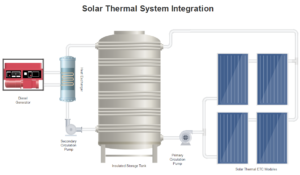
ABSTRACT
Due to the rapid industrial growth in India, many corporate and industrial companies are moving towards renewable and energy efficient systems for their process systems to reduce their utility cost. As a new member to this venture, TVS Motors met with the pioneers of energy efficient heating solutions provider, Aspiration Energy Private Limited to utilize solar thermal energy for their engine head block heating. Initially, the electrical heaters with forced circulation systems were used to heat the engine block head to 55 °C.
Preliminarily, Aspiration Energy did an energy survey of electrical heater consumption pattern and temperature requirement and proposed a suitable energy efficient rooftop solar thermal system.
The 225 kW system is installed on the rooftop of the plant occupying a roof space of 749 m2. The modules have been arranged in a series – parallel combination to maintain the required temperature of 55 °C at the end application. The project was designed to deliver heat for 24-hour operations. A lagged, unsheltered storage tank had been installed which acts as a thermal energy accumulator. The thermal energy generated is accumulated inside this accumulator during the sunshine hours and utilized when the solar irradiation is not available.
The plant is installed on CAPEX model. Through the installation of 225 kW Solar ETC plant, the average savings per day is 1031 kWh and the average heater energy consumption per day is 169 kWh, for the one month performance observation.
This has enabled TVS to eliminate significant carbon footprint with the replacement of their energy source with a renewable source.
INTRODUCTION
For smoother starting of industrial generators, it is provided with water jackets over the engine cylinder for quick start in cold weather as well as reducing the diesel consumption at the startup. Typically, most of the industrial generators use block heater to serve this purpose. A block heater warms an engine to increase the chances that the engine will start as well as warm up the engine cylinder faster than it normally would in extremely cold weather.
The most common type is an electric heating element in the cylinder block, connected through a power supply. The block heater may replace one of the engine’s core plugs. In this fashion, the heater element is immersed in the engine’s coolant, which then keeps most of the engine warm. This type of heater does not come with a pump. They may also be installed in line with one of the radiator or heater hoses. Some heaters pump and circulate the engine coolant while heating; others only heat the still coolant in the reservoir.
The Diesel Generators of 4 numbers installed in TVS Motors use forced circulation engine heating systems. The rated capacity of each block heaters is 25kW. The heater maintains the engine block temperature to 55 °C.
BACKGROUND
TVS Motor is the third largest two-wheeler manufacturer in India, with revenue of 11,244 Cr INR (2015-16). The company has annual production capacity of 3.2 million 2 wheelers & 1.2 Lakh 3 wheelers. TVS Motor Company Ltd (TVS Motor), member of the TVS group (Revenue around INR. 40,000 Cr in 2015-16), is the largest company of the group in terms of size and turnover.
TVS Motor, Hosur (TVSM) plant uses Diesel Generator as a backup power source during the time of power failures. To reduce the start-up time of the Diesel generator the engine head must be maintained at constant temperature and this is done with the help of forced circulation electrical heating system. Because of this continuous requirement to maintain constant temperature in the engine block, the electrical heaters consume about 1200 kWh per day.
With the help of Aspiration Energy, TVSM planned to reduce their power consumption along with their carbon footprint for this application.
The main objective of this project is to replace the existing heating system with solar thermal system on unused roof structure.
SOLUTION
After detailed study and analysis on the energy consumption pattern for the electrical heaters, Aspiration Energy came up with a highly efficient solar thermal system design with energy accumulator to serve the heat requirement for 24-hour operation of engine head block heating.
The designed capacity of total system is 225 kW and consists of 50 modules of 4.5 kW each. The solar thermal systems are designed in such a way that even at the winter season, the system will deliver the required heat output to maintain the engine block temperature at 55 °C.

The system is designed with butterfly-shaped Evacuated Glass Tube Collectors (ETC). Each ETC module is rated at 4.5 kW thermal capacity with 7.7 m2 aperture area.
The system was installed with 2 modules in series connection and 25 pairs of modules in parallel connection with reverse return header.
The primary circulation of the system was driven by a multistage centrifugal pump which circulates water from storage tank to solar thermal modules and back to storage tank. When solar direct radiation falls on ETC glass tubes, the water flowing through the tubes heats up and returns to storage tank. After multiple passes through the modules, the
water can be heated up to 95 °C at maximum solar radiation.
The hot water stored in the tank is pumped by secondary circulation pump and delivers it to the plate heat exchangers installed for each generator.
The plate heat exchangers are integrated in such a way that the existing heater element is connected parallel to the plate heat exchanger – so that the electrical heater acts as the main heating element when solar thermal is idle in adverse weather conditions.
The engine heads are heated up by indirect heat transfer between the solar water and jacket water with the use of plate heat exchanger. The hot water from solar thermal modules flows in hot side while the jacket water from engine from engine circulation flows through the cold side.
After successfully installing the system, the average savings per day is 1031 kWh and the average heater energy consumption per day is 169 kWh for the given solar radiation in the month under observation.
The table shows the heater energy consumption and percentage cost savings for the month of March 2017.
| Date | Heater Energy Consump–tion | Energy Savings | Cost Savings |
| (kWh) | (%) | ||
| 03-01-17 | 158 | 1042 | 86.83 |
| 03-02-17 | 243 | 957 | 79.75 |
| 03-03-17 | 255 | 945 | 78.75 |
| 03-04-17 | 207 | 993 | 82.75 |
| 03-05-17 | 99 | 1101 | 91.75 |
| 03-06-17 | 196 | 1004 | 83.67 |
| 03-07-17 | 238 | 962 | 80.17 |
| 03-08-17 | 202 | 998 | 83.17 |
| 03-09-17 | 98 | 1102 | 91.83 |
| 03-10-17 | 254 | 946 | 78.83 |
| 03-11-17 | 85 | 1115 | 92.92 |
| 03-12-17 | 24 | 1176 | 98 |
| 3/13/2017 | 98 | 1102 | 91.83 |
| 3/14/2017 | 647 | 553 | 46.08 |
| 3/15/2017 | 671 | 529 | 44.08 |
| 3/16/2017 | 188 | 1012 | 84.33 |
| 3/17/2017 | 96 | 1104 | 92 |
| 3/18/2017 | 238 | 962 | 80.17 |
| 3/19/2017 | 57 | 1143 | 95.25 |
| 3/20/2017 | 49 | 1151 | 95.92 |
| 3/21/2017 | 67 | 1133 | 94.42 |
| 3/22/2017 | 41 | 1159 | 96.58 |
| 3/23/2017 | 78 | 1122 | 93.5 |
| 3/24/2017 | 163 | 1037 | 86.42 |
| 3/25/2017 | 162 | 1038 | 86.5 |
| 3/26/2017 | 128 | 1072 | 89.33 |
| 3/27/2017 | 224 | 976 | 81.33 |
| 3/28/2017 | 45 | 1155 | 96.25 |
| 3/29/2017 | 67 | 1133 | 94.42 |
| 3/30/2017 | 89 | 1111 | 92.58 |
| 3/31/2017 | 58 | 1142 | 95.17 |

CONCLUSION
With this implementation of 225 kW system, TVS Motors reaps from monetary benefits as well the social benefit of making the workforce aware of clean and renewable energy system. From this paper, it is noted that the installed solar thermal system conserves on average 86 percent of the existing cost with the average energy savings per day being 1031 kWh. With higher solar radiation at the site during summer months, it is expected to save on entire electric heater consumption costs.
FOR MORE INFORMATION
Aspiration Energy is an innovative Solar Energy Services company based in Chennai, providing decentralized solar thermal systems for industrial process heating & offering solar power plants at attractive returns. For industries that adopt to green energy initiatives, we offer solar energy generation systems that provide long term predictable low-energy costs on a unique monthly performance based energy payment. We avoid expensive and dirty fossil fuels by adopting proven technologies to both unutilized space and complex applications in the industry.
